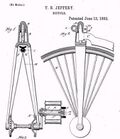Engineering:Tire bead


Tire bead is the term for the edge of a tire that sits on the rim. Wheels for automobiles, bicycles, etc. are made with a small slot or groove into which the tire bead sits. When the tire is properly inflated, the air pressure within the tire keeps the bead in this groove.
It is common amongst drivers of off-road vehicles to decrease the air pressure in their tires.[1] This makes the tread of the tire spread out, creating more surface area for the tire's tread to grip the terrain. If the pressure is too low, there may not be enough pressure to keep the bead on the rim, thus causing the bead to pop off the rim; this is often referred to as "losing a bead". Beadlocks, which clamp the bead on the rim, are often used in this case.
Often, the bead can become frozen to the rim after rusting occurs, requiring the use of a bead breaker.
Materials Used for Tire Bead
Tire beads are made of high-tensile steel cable coated with rubber and are responsible for creating and maintaining a seal between the tire and the wheel. The steel wire used to make tire beads is often plated with copper, brass, or bronze to increase its strength. Here are some other materials used in tire manufacturing that are suitable for the tire application:
- Cotton
- Rayon
- Polyester
- Steel
- Fiberglass
- Aramid
While these materials are used in different parts of the tire, the tire bead is primarily made of steel wire coated with rubber.
References
 |

